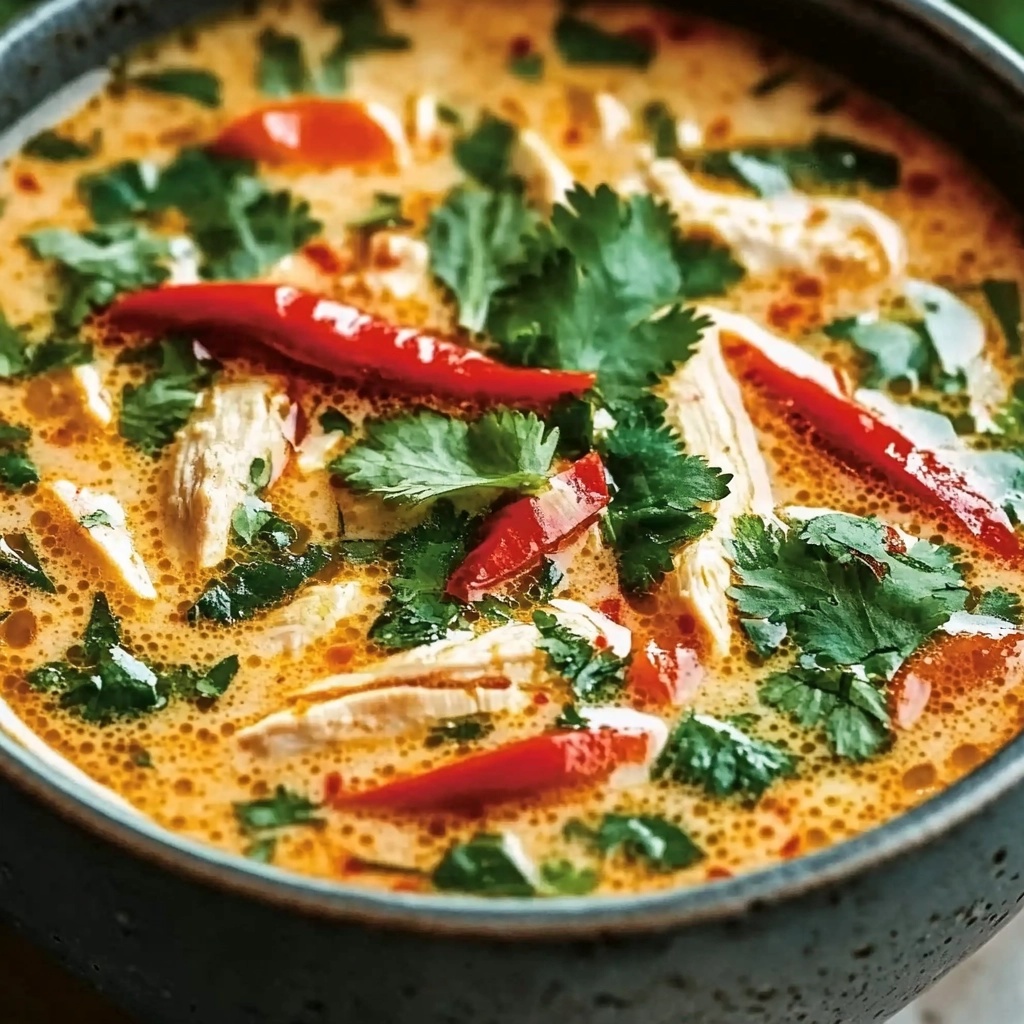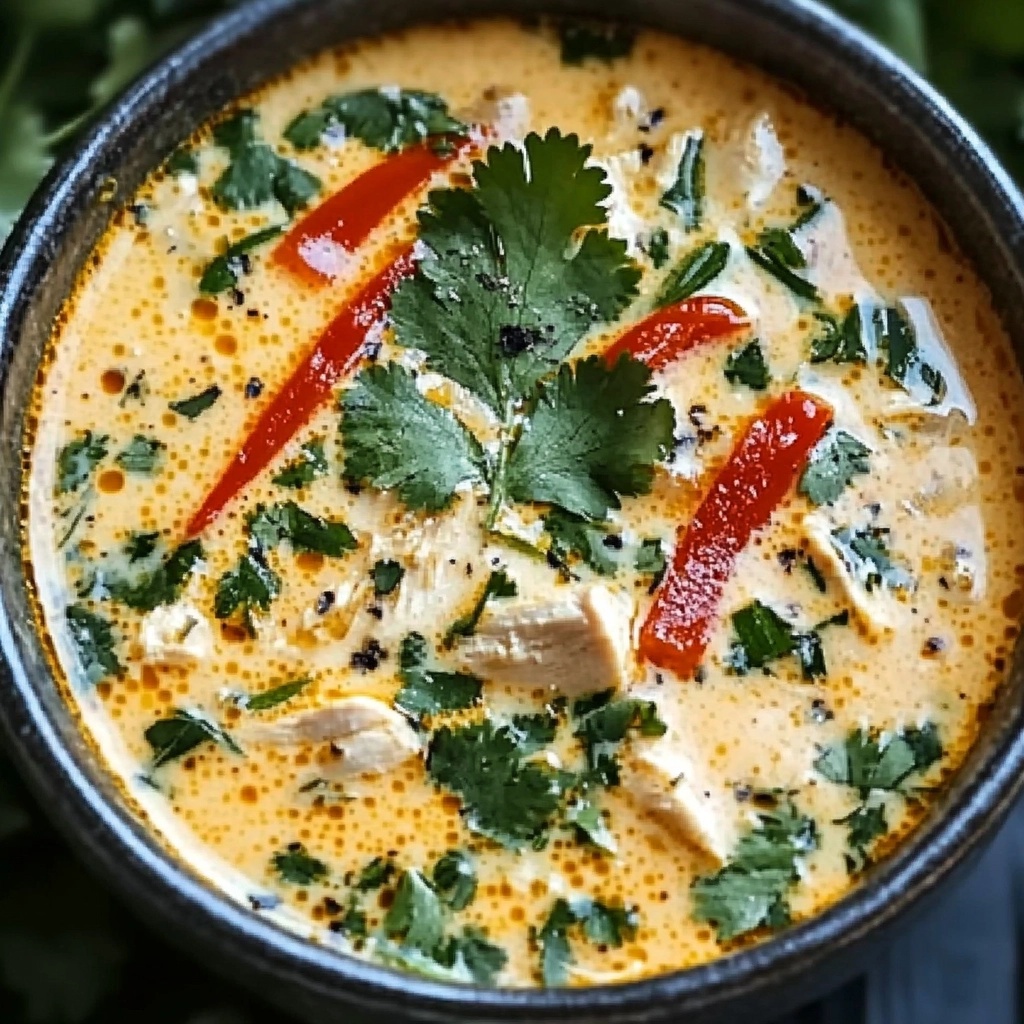Thai Coconut Chicken Soup is a rich and flavorful dish inspired by Thai cuisine. This creamy soup is made with coconut milk, chicken, and aromatic herbs and spices such as ginger, garlic, and red curry paste. The result is a warm, comforting dish that is both rich in flavor and textures, making it the perfect comfort food for a variety of occasions.
This soup is known for its balance of sweet, salty, spicy, and sour notes, a hallmark of traditional Thai cuisine. The coconut milk provides the creamy, velvety base, while the red curry paste gives the soup its distinct depth of flavor. Vegetables like mushrooms, carrots, and bell peppers add color and texture, complementing the richness of the broth.
In addition to its complex flavor profile, Thai Coconut Chicken Soup is also incredibly versatile. You can easily adjust the heat level to suit your taste by adding more or less chili. This makes it suitable for both spice lovers and those who prefer milder flavors. Whether you’re enjoying it as a weeknight dinner or preparing it for meal prep, this soup can be customized to fit your preferences.
For a deeper dive into how this soup fits into the broader context of Thai cooking, you can explore the Wikipedia entry on Thai Cuisine. It’s a great resource to understand the diverse flavors that make up the backbone of Thai food.
Why Thai Coconut Chicken Soup?
Why choose Thai Coconut Chicken Soup? It’s not just about the taste; it’s also about the health benefits and ease of preparation. With ingredients like chicken, coconut milk, and fresh vegetables, this soup can be both nutritious and filling.
-
Chicken provides a lean source of protein, making the soup satisfying and hearty.
-
Coconut milk is rich in healthy fats, particularly medium-chain triglycerides (MCTs), which are easily absorbed and can provide an energy boost.
-
Fresh ginger and garlic are not only aromatic but also have numerous health benefits. Ginger has anti-inflammatory properties, while garlic is known for its immune-boosting effects.
-
The vegetables, such as carrots and bell peppers, add fiber, vitamins, and antioxidants to the dish, making it a well-rounded, nutritious meal.
Moreover, the ease of preparation is one of the key reasons why this soup is a popular choice for busy weeknights or meal prep. By using a crockpot, the recipe requires minimal hands-on time. Simply add the ingredients, set the crockpot, and let it do the work. In about 6-7 hours, you’ll have a flavorful, aromatic soup ready to serve.
If you’re looking to explore more crockpot recipes, you can check out this Pinterest board with crockpot ideas. It’s a great place to find more slow-cooked meal inspirations.

Why This Recipe Works
This specific Thai Coconut Chicken Soup recipe works for several reasons:
-
Simple, Accessible Ingredients: The ingredients used in this recipe are easily accessible at most grocery stores, and many of them may already be staples in your kitchen. The combination of coconut milk, chicken broth, soy sauce, and red curry paste delivers authentic flavors without the need for specialty items.
-
Crockpot Convenience: The use of a crockpot (slow cooker) makes this recipe perfect for those with busy schedules. Unlike traditional stovetop methods, the crockpot allows you to set it and forget it, ensuring that your soup cooks slowly, which enhances the flavors.
-
Customizable Heat Level: The recipe includes chili flakes as an optional ingredient, allowing you to adjust the spiciness to your liking. Whether you prefer a mild soup or a more fiery version, this flexibility is a key feature of the recipe.
-
Balanced Flavors: The balance of sweet, salty, sour, and spicy flavors is crucial in Thai cooking, and this soup nails that combination. The sweetness from the brown sugar, the saltiness from the soy sauce, the heat from the red curry paste, and the tanginess from the lime juice create a harmonious dish.
To learn more about the key ingredients in this soup, such as soy sauce and coconut milk, you can visit their respective Wikipedia pages on soy sauce and coconut milk for further details on their origins and uses.
How to Serve
Thai Coconut Chicken Soup is perfect on its own as a light meal or served with a side of rice or noodles. You can also garnish it with fresh cilantro, which adds a burst of freshness to every bite. The soup can be enjoyed immediately or stored for later consumption, making it a great option for meal prep.
With its bold flavors and ease of preparation, this soup is sure to become a new favorite in your recipe rotation. Whether you’re looking for a quick dinner or a flavorful dish to impress your guests, Thai Coconut Chicken Soup offers the perfect balance of simplicity and sophistication.
The Ingredients and Their Role
Chicken Breasts (Protein Base)
The foundation of any chicken soup is the protein, and in this recipe, boneless, skinless chicken breasts are the star. Chicken breasts are ideal because they are lean, easy to shred, and absorb the flavors of the soup beautifully. Using boneless and skinless breasts simplifies the preparation, as you don’t need to remove bones or skin before cooking. As the chicken simmers in the crockpot, it becomes tender and easy to shred with just a fork.
This lean protein also helps balance out the rich, creamy nature of the soup, making it both satisfying and nutritious. Chicken provides essential amino acids, helping to support muscle health and repair. If you prefer dark meat, you can also use boneless chicken thighs, which will impart a richer flavor.
Coconut Milk (Creaminess and Flavor)
Coconut milk is the key ingredient that gives this soup its signature creaminess and depth of flavor. It creates a velvety texture that pairs perfectly with the other ingredients, making the soup both indulgent and comforting. There are two types of coconut milk available: full-fat and light coconut milk. For this recipe, full-fat coconut milk is recommended to achieve the rich, creamy consistency, though light coconut milk can be used if you’re looking for a lower-calorie version.
Coconut milk is also a great source of healthy fats, particularly medium-chain triglycerides (MCTs), which are easily absorbed and converted into energy. These fats can also help promote heart health. For a more in-depth understanding of how coconut milk is produced and its uses in cooking, you can visit its Wikipedia page on coconut milk.
Chicken Broth (Flavor Foundation)
Chicken broth forms the base of the soup, helping to create a flavorful and hearty liquid that ties the other ingredients together. The savory richness of the broth enhances the chicken, coconut milk, and spices, giving the soup a depth of flavor. While you can use store-bought chicken broth, homemade chicken broth provides an even richer, more nuanced flavor.
For those looking to make the soup vegetarian or vegan, vegetable broth can be used as a substitute, ensuring that the flavor profile remains full and satisfying. If you want to make your own broth, you can find detailed instructions in resources like Pinterest’s chicken broth recipes.
Red Curry Paste (Spice and Depth)
Red curry paste is an essential ingredient in Thai cooking, providing the base for many dishes, including this soup. Made from red chilies, garlic, lemongrass, and other spices, red curry paste brings an unmistakable boldness and spice to the dish. It gives the soup its signature flavor profile—both spicy and aromatic, with a slight sweetness.
The heat level of the soup can be adjusted by using more or less curry paste, depending on your tolerance for spice. If you’re concerned about the soup being too spicy, you can start with a small amount and gradually increase it as needed. For more on how to make red curry paste, you can check the Wikipedia entry on curry paste.
Soy Sauce & Brown Sugar (Balancing Salty and Sweet)
The combination of soy sauce and brown sugar plays an important role in balancing the savory and sweet elements of the soup. Soy sauce brings saltiness and umami, which intensifies the flavor of the coconut milk and chicken broth. Meanwhile, brown sugar adds a touch of sweetness that balances the heat from the curry paste and the acidity from the lime juice.
This sweet-salty contrast is typical in Thai cuisine, where flavors are carefully balanced to create harmony in each dish. If you’re looking for a gluten-free version, you can easily substitute tamari (a gluten-free soy sauce) for regular soy sauce. For more on the differences between soy sauces and their uses, refer to the Wikipedia article on soy sauce.
Ginger and Garlic (Aromatic Elements)
Both ginger and garlic are key aromatics in this soup, enhancing its overall fragrance and contributing essential flavors. Ginger adds a fresh, zesty kick that brightens up the creamy base of the soup. It’s also known for its anti-inflammatory properties and digestive benefits. Garlic, on the other hand, adds a savory depth that complements the sweetness of the coconut milk and the spiciness of the curry paste.
Together, ginger and garlic help create the characteristic warmth and aroma that define many Thai dishes. If you love these flavors, you can increase their amounts for a more intense taste. Learn more about the health benefits of ginger on its Wikipedia page.
Vegetables (Color, Texture, and Nutrients)
The addition of fresh vegetables like mushrooms, red bell pepper, and carrots enhances both the color and texture of the soup. These vegetables not only add visual appeal, but they also provide nutritional benefits.
-
Mushrooms add earthiness and umami, deepening the soup’s overall flavor profile.
-
Red bell pepper brings sweetness and vibrant color to the dish.
-
Carrots offer natural sweetness, color, and a slight crunch that contrasts beautifully with the creamy broth.
Incorporating these vegetables also helps make the soup more well-rounded in terms of nutrients, offering fiber, vitamins, and antioxidants. Feel free to experiment with other vegetables, such as zucchini or spinach, to suit your preferences.
Lime Juice and Cilantro (Final Touches)
Lime juice is the perfect finishing touch for Thai Coconut Chicken Soup. It cuts through the richness of the coconut milk, adding a refreshing acidity that brightens the flavors. The zesty tang from the lime is an essential contrast to the creaminess of the broth and balances the dish’s complexity.
Fresh cilantro, added as a garnish, provides a burst of freshness and enhances the aromatic qualities of the soup. It’s a traditional garnish in many Thai dishes and gives the soup a beautiful, vibrant appearance. Additionally, cilantro pairs perfectly with the lime and helps round out the flavors of the soup.
Optional Ingredients (Chili Flakes for Heat)
For those who enjoy a bit of spice, chili flakes are a great optional addition. If you’re looking for more heat, you can add more chili flakes to the soup when serving. Alternatively, you can adjust the level of spiciness during cooking by adding more red curry paste or chili peppers.
Adjusting the heat level of the soup makes it customizable, allowing you to tailor it to different tastes. Whether you prefer a mild soup or a fiery dish, these optional ingredients ensure you can enjoy the perfect level of spice for your palate.
Step-by-Step Instructions for Crockpot Thai Coconut Chicken Soup
Step 1: Prepare Your Chicken
Start by placing your boneless, skinless chicken breasts at the bottom of the crockpot. It’s important to use chicken that is evenly sized so that it cooks at the same rate. This step is crucial because the chicken will cook in the broth and absorb the flavors, so make sure the chicken breasts are positioned evenly in the crockpot.
For a quick prep, you can cut the chicken into smaller pieces, but it’s not necessary. Cooking the chicken whole will allow it to remain tender and juicy, and you can easily shred it later on.
Step 2: Mix the Soup Base
In a separate bowl, combine the following ingredients to create the base for your soup:
-
Coconut milk (14 oz)
-
Chicken broth (4 cups)
-
Red curry paste (1 tbsp)
-
Soy sauce (1 tbsp)
-
Brown sugar (2 tbsp)
-
Fresh ginger, minced (1 tbsp)
-
Garlic cloves, minced (3 cloves)
Stir the ingredients well to ensure the curry paste dissolves into the liquid, creating a smooth, cohesive soup base. This mixture will give your soup its signature flavor, so take care to mix it thoroughly.
Once everything is mixed, pour this soup base evenly over the chicken breasts in the crockpot. The chicken will soak up the flavors, creating a deliciously aromatic base as it cooks.
Step 3: Add Vegetables
Now it’s time to add your vegetables to the crockpot:
-
Mushrooms, sliced (1 cup)
-
Red bell pepper, thinly sliced (1)
-
Carrot, julienned (1 medium)
These vegetables not only add texture and color to the soup but also contribute their own natural flavors, enhancing the overall dish. You don’t need to worry about cooking them before adding them to the crockpot, as they’ll soften perfectly during the slow cooking process.
Make sure the vegetables are evenly distributed on top of the chicken and broth. The heat from the crockpot will ensure the vegetables cook through and become tender.
Step 4: Cooking the Soup
Cover the crockpot with its lid and set it to cook on low heat for 6-7 hours. The slow cooking process allows the chicken to become tender and absorb the flavors of the broth. The soup will also thicken slightly as the coconut milk melds with the chicken broth and spices.
It’s important to let the soup cook on low for the best results. Cooking it on high heat may cause the chicken to become tough, so patience is key for this step.
You can check on the soup after 6 hours to see if the chicken is cooked through. The chicken should be tender enough to shred with a fork.
Step 5: Shred the Chicken
Once the chicken is fully cooked, carefully remove the chicken breasts from the crockpot and place them on a cutting board. Using two forks, shred the chicken into bite-sized pieces.
Shredding the chicken allows it to absorb more of the flavorful broth, ensuring that each spoonful of soup has the perfect mix of tender chicken and creamy liquid.
Return the shredded chicken to the soup in the crockpot, stirring gently to incorporate it back into the broth. The shredded chicken will add texture and absorb even more flavor as it sits in the broth.
Step 6: Add Lime and Final Seasoning
After the chicken is shredded and reintroduced to the soup, it’s time to add a final burst of freshness:
-
Lime juice (1 tbsp or more to taste)
-
Chili flakes (optional, 1-2 tsp)
The lime juice adds a tangy, fresh acidity that balances the richness of the coconut milk and enhances the flavors. If you prefer a tangier flavor, you can always add more lime juice to taste.
The chili flakes are optional, depending on how much heat you enjoy in your soup. If you prefer a mild soup, you can skip this step, or you can add them to give the dish an extra kick.
Taste the soup and adjust the seasoning if necessary. If you’d like it saltier, you can add a touch more soy sauce. If it needs sweetness, a pinch more brown sugar can do the trick.
Step 7: Serve and Garnish
Your soup is now ready to serve! Ladle it into bowls and garnish with fresh cilantro to add a burst of color and flavor. Cilantro not only provides a fresh herbal note but also adds a beautiful pop of green to the dish.
Serve the soup hot, accompanied by a side of rice or noodles if desired. This soup is rich and hearty, and pairing it with a side helps to round out the meal.

Variations and Customization Ideas
Vegetarian or Vegan Version
If you’re looking to make this soup vegetarian or vegan, there are a few easy swaps you can make:
-
Replace the chicken breasts with tofu or tempeh. These plant-based proteins soak up the flavors of the broth and create a satisfying texture.
-
Use vegetable broth in place of the chicken broth to make the soup entirely plant-based.
-
For a dairy-free option, ensure that the coconut milk is the only source of creaminess and that no dairy-based ingredients are used in your broth or garnishes.
These substitutions will still allow you to enjoy the rich, flavorful essence of the soup, with a different protein and a plant-based twist.
Spice Levels
The beauty of this recipe lies in its flexibility. You can adjust the spice level to suit your preferences:
-
For a milder version, use only a small amount of red curry paste (start with 1 teaspoon) and skip the chili flakes.
-
For a spicier version, increase the red curry paste and add fresh chili peppers or more chili flakes to ramp up the heat.
-
You can also try adding Sriracha sauce or Thai bird’s eye chilies for an added layer of heat.
Noodle Addition
For a more filling meal, you can add rice noodles, soba noodles, or egg noodles to the soup. Cook the noodles separately and add them to the soup just before serving. The noodles will absorb the broth, adding more texture and flavor.
Additional Vegetables
Feel free to experiment with other vegetables to change up the flavor profile. For example:
-
Zucchini adds a mild flavor and soft texture, perfect for absorbing the soup’s rich broth.
-
Spinach or bok choy can be added for a healthy, green addition.
-
Baby corn or water chestnuts provide a satisfying crunch and are often found in traditional Thai soups.
By adjusting the vegetable variety, you can make the soup more colorful and nutrient-packed, tailoring it to your tastes or dietary needs.
Tips for the Perfect Thai Coconut Chicken Soup
Slow Cooking Tips
To ensure your soup is perfectly tender, be sure to use low heat when cooking in the crockpot. While it may be tempting to use the high setting to speed up the process, the low heat will allow the chicken to cook more evenly and stay juicy. Additionally, slow cooking allows the flavors to meld together, creating a more complex and well-rounded broth.
Balancing Flavors
Taste the soup throughout the cooking process and adjust the seasoning as needed. If the soup feels too salty, add a little more lime juice or sugar to balance the flavors. If it’s too spicy, a bit more coconut milk or chicken broth can mellow out the heat. The key to a successful Thai soup is finding the right balance of sweet, salty, spicy, and sour.
Storing and Reheating
This soup makes excellent leftovers and is even better the next day as the flavors continue to develop. To store it, simply place the soup in an airtight container and refrigerate for up to 3 days. You can also freeze the soup in a freezer-safe container for up to 3 months.
To reheat, place the soup in a pot over low heat, stirring occasionally to prevent it from sticking. You may need to add a splash of chicken broth or water to adjust the consistency, as the soup may thicken slightly after refrigeration.

Frequently Asked Questions (FAQs)
Can I make Thai Coconut Chicken Soup without a crockpot?
Yes! If you don’t have a crockpot, you can easily make this soup on the stovetop. Simply simmer the soup ingredients in a large pot over low heat for about 45 minutes to 1 hour, until the chicken is fully cooked. Shred the chicken and adjust the seasoning as needed.
Can I freeze Thai Coconut Chicken Soup?
Absolutely! This soup freezes well. Let it cool completely before transferring it to an airtight container or freezer bag. It will keep in the freezer for up to 3 months. To reheat, defrost overnight in the fridge and reheat on the stovetop.
How can I make Thai Coconut Chicken Soup spicier?
If you like more heat, try adding Thai bird’s eye chilies or extra red curry paste. You can also increase the amount of chili flakes or serve the soup with hot sauce for an extra kick.
Can I use other types of meat for this soup?
Yes! You can substitute chicken with other meats such as shrimp, pork, or even beef. For shrimp, add them during the last 30 minutes of cooking so they don’t overcook.
Is Thai Coconut Chicken Soup gluten-free?
Yes, this soup is naturally gluten-free. Just be sure to use gluten-free soy sauce (tamari) if you are sensitive to gluten.
-
-
Anchor Text: “Coconut Milk’s Role in Thai Coconut Chicken Soup”
-
-
-
Anchor Text: “Understanding Red Curry Paste in Thai Recipes”
-
-
-
Anchor Text: “The Health Benefits of Ginger in Cooking”
-
-
-
Anchor Text: “How Chicken Broth Enhances the Soup’s Flavor”
-
-
-
Anchor Text: “Adding Fresh Cilantro for a Bright Finish”
-
-
-
Anchor Text: “The Role of Soy Sauce in Balancing Flavors”
-
-
-
Anchor Text: “Using Lime Juice to Add Acidity and Freshness”
-
-
Mushroom Varieties – Pinterest
-
Anchor Text: “Choosing the Best Mushrooms for Thai Coconut Soup”
-
-
-
Anchor Text: “Explore More Crockpot Recipe Ideas”
-
-
Anchor Text: “Exploring the Rich Flavors of Thai Cuisine”
The Ultimate Guide to Making Thai Coconut Chicken Soup
This Thai Coconut Chicken Soup is a rich and comforting dish that combines the creaminess of coconut milk with bold Thai flavors like red curry paste, ginger, and lime. Made in a crockpot for convenience, this soup is packed with tender shredded chicken, vibrant vegetables, and a balance of sweet, salty, spicy, and sour elements. Whether you’re craving a warm meal on a chilly evening or preparing a flavorful dish for meal prep, this easy recipe is sure to become a new favorite in your kitchen. Garnished with fresh cilantro and a squeeze of lime juice, each bowl offers a burst of flavor that is both satisfying and nourishing. It’s customizable to suit any taste preference, from adjusting the heat level to adding extra vegetables or noodles for added substance.
- Author: Clara
Ingredients
- 4 boneless, skinless chicken breasts
- 1 can (14 oz) coconut milk
- 4 cups chicken broth
- 1 tbsp red curry paste
- 1 tbsp soy sauce
- 2 tbsp brown sugar
- 1 tbsp fresh ginger, minced
- 3 garlic cloves, minced
- 1 cup mushrooms, sliced
- 1 red bell pepper, thinly sliced
- 1 medium carrot, julienned
- 1 tbsp lime juice
- Fresh cilantro, chopped (for garnish)
- 1–2 tsp chili flakes (optional for heat)
Instructions
Place the chicken breasts in the bottom of your crockpot.
In a bowl, combine coconut milk, chicken broth, red curry paste, soy sauce, brown sugar, minced ginger, and minced garlic. Stir to mix well.
Pour the coconut milk mixture over the chicken in the crockpot. Add the mushrooms, red bell pepper, and carrot.
Cover and cook on low for 6-7 hours, or until the chicken is fully cooked and tender.
Remove the chicken breasts from the crockpot and shred with two forks. Return the shredded chicken to the soup.
Stir in lime juice and chili flakes (if using). Taste and adjust seasoning if needed.
Serve the soup hot, garnished with fresh cilantro.
Notes
-
Slow Cooking: The key to making this soup in a crockpot is low and slow cooking. The chicken breasts will become perfectly tender and absorb the flavors of the broth, creating a rich and flavorful base.
-
Adjusting Spice Level: The red curry paste provides the primary spice in this recipe. If you like it spicier, feel free to add more curry paste or increase the amount of chili flakes to taste.
-
Tofu Substitute: For a vegan or vegetarian version, you can replace the chicken with tofu or tempeh. These plant-based proteins work wonderfully with the coconut milk broth and absorb the flavors well.
-
Storage: This soup stores beautifully in the refrigerator for up to 3 days. It also freezes well for up to 3 months. Just be sure to let it cool completely before storing in airtight containers. When reheating, you may need to add a little bit of chicken broth or water to restore the soup’s consistency.
-
Flavor Enhancements: Feel free to customize the flavor profile by adding more vegetables like spinach, baby corn, or zucchini, or by incorporating rice noodles for a heartier dish.
-
Garnishing: Fresh cilantro and a squeeze of lime juice just before serving bring the dish together and give it a refreshing lift.




